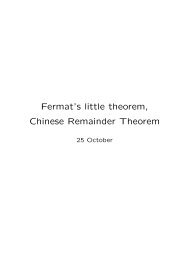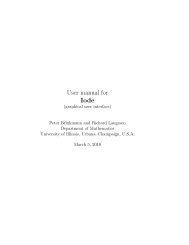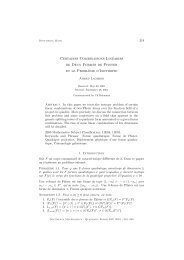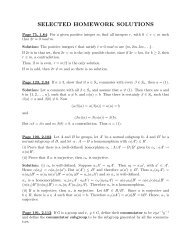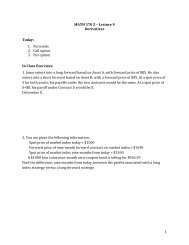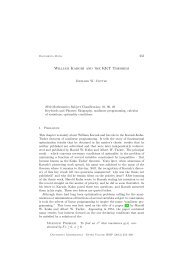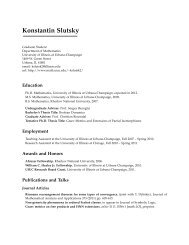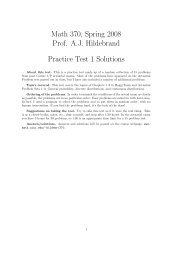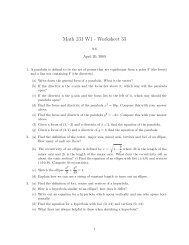Math 527 - Homotopy Theory Spring 2013 Homework 3 Solutions ...
Math 527 - Homotopy Theory Spring 2013 Homework 3 Solutions ...
Math 527 - Homotopy Theory Spring 2013 Homework 3 Solutions ...
You also want an ePaper? Increase the reach of your titles
YUMPU automatically turns print PDFs into web optimized ePapers that Google loves.
<strong>Math</strong> <strong>527</strong> - <strong>Homotopy</strong> <strong>Theory</strong><br />
<strong>Spring</strong> <strong>2013</strong><br />
<strong>Homework</strong> 3 <strong>Solutions</strong><br />
Problem 1. An H-space (named after Hopf) is a pointed space (X, e) equipped with a<br />
“multiplication” map µ: X × X → X such that the basepoint e is a two-sided unit up to<br />
pointed homotopy. In other words, both maps<br />
µ(e, −): X → X<br />
µ(−, e): X → X<br />
and pointed-homotopic to the identity map idX. Note that µ is not assumed to be associative,<br />
not even up to homotopy.<br />
Show that the fundamental group π1(X, e) of an H-space is abelian.<br />
Solution. Let us show a stronger result: The π1(X, e)-action on πn(X, e) is trivial for all<br />
n ≥ 1.<br />
Let [γ] ∈ π1(X, e) and [θ] ∈ πn(X, e) be represented by pointed maps γ : S 1 → X and θ : S n →<br />
X (by abuse of notation), or equivalently, maps of pairs γ : (I, ∂I) → (X, e) and θ : (D n , ∂D n ) →<br />
(X, e).<br />
Consider the continuous map H : D n × I → X defined by<br />
Then H restricted to the bottom face is<br />
whereas H restricted to the remaining faces is<br />
H(z, s) = µ (θ(z), γ(s)) .<br />
H|D n ×{0} = θe<br />
H|∂D n ×I∪D n ×{1} = (eγ) · (θe)<br />
so that H provides a pointed homotopy between θe and (eγ) · (θe).<br />
Because right multiplication by e is pointed-homotopic to the identity of X, the composite<br />
S n<br />
θ<br />
<br />
X<br />
θe<br />
µ(−,e)<br />
<br />
X<br />
<br />
is pointed-homotopic to θ, yielding the equality [θe] = [θ] in πn(X, e). Likewise, the equality<br />
[eγ] = [γ] holds in π1(X, e). We obtain the equality<br />
in πn(X, e).<br />
[γ] · [θ] = [eγ] · [θe]<br />
= [θe]<br />
= [θ]<br />
1
Problem 2. Let f : X → Y be a map of spaces, and x ∈ X any basepoint. Show that the<br />
induced map<br />
πnf : πn(X, x) → πn(Y, f(x))<br />
for n ≥ 1 is a map of π1-modules, in the sense that it is π1f-equivariant. More precisely, for<br />
any γ ∈ π1(X, x) and θ ∈ πn(X, x) the equation<br />
holds in πn(Y, f(x)).<br />
(πnf)(γ · θ) = (π1f)(γ) · (πnf)(θ)<br />
Solution. The equation to be proved can be written as the commutative diagram<br />
π1(X, x) × πn(X, x)<br />
π1f×πnf<br />
<br />
π1(Y, f(x)) × πn(Y, f(x))<br />
•<br />
•<br />
<br />
πn(X, x)<br />
πnf<br />
<br />
<br />
πn(Y, f(x))<br />
Recall that the action map π1(X, x) × πn(X, x) • −→ πn(X, x) is obtained by applying the functor<br />
[−, X]∗ : Top op<br />
∗ → Set∗ to the coaction map c: S n → S 1 ∨ S n .<br />
The map f : (X, x) → (Y, f(x)) in Top ∗ yields the postcomposition natural transformation<br />
f∗ : [−, X]∗ → [−, Y ]∗. Applying f∗ to the coaction map c yields the commutative right-hand<br />
square of the diagram<br />
[S 1 , (X, x)]∗ × [S n , (X, x)]∗<br />
<br />
f∗×f∗<br />
[S 1 , (Y, f(x))]∗ × [S n , (Y, f(x))]∗<br />
<br />
<br />
∼=<br />
∼=<br />
[S 1 ∨ S n , (X, x)]∗<br />
<br />
f∗<br />
[S 1 ∨ S n , (Y, f(x))]∗<br />
c ∗<br />
c ∗<br />
<br />
[S n , (X, x)]∗<br />
f∗<br />
<br />
<br />
[Sn , (Y, f(x))]∗<br />
where the left-hand square also commutes, since the wedge is the coproduct in Top ∗ and in<br />
Ho(Top ∗). But the outer diagram in (2) is precisely the diagram (1).<br />
2<br />
(1)<br />
(2)
Problem 3. Let X be the topologist’s sine curve:<br />
X = {0} × [−1, 1] ∪ {(x, sin 1<br />
) | 0 < x ≤ 1}.<br />
x<br />
Consider the map f : S 0 → X which picks out the points (0, 1) and (1, sin 1). Show that this<br />
map f is a weak homotopy equivalence but not a homotopy equivalence.<br />
Solution. Write A = {0} × [−1, 1] and B = {(x, sin 1)<br />
| 0 < x ≤ 1} with X = A ∪ B where<br />
x<br />
the union is disjoint. Recall that X is connected (being the closure of the connected subset<br />
B ⊂ R2 ), but not path-connected. The two path components of X are A and B.<br />
f is a weak homotopy equivalence. Write a := (0, 1) ∈ A and b := (1, sin 1) ∈ B, and<br />
S 0 = {∗a, ∗b}, with f(∗a) = a and f(∗b) = b. The map f : S 0 → X induces a bijection on the<br />
sets of path components π0f : π0(S 0 ) −→ π0(X) = {[a], [b]}.<br />
Since S n is path-connected for all n ≥ 1, any pointed map α: S n → (X, a) lands inside the<br />
path component A ⊆ X. But A is contractible, so that πn(A, a) = 0 and α: S n → (A, a) is<br />
pointed-null-homotopic. This proves πn(X, a) = 0. Therefore πnf : πn(S 0 , ∗a) −→ πn(X, a) is an<br />
isomorphism (between trivial groups!) for all n ≥ 1.<br />
Likewise, B is contractible, so that πnf : πn(S 0 , ∗b) −→ πn(X, b) is also an isomorphism (between<br />
trivial groups) for all n ≥ 1.<br />
f is not a homotopy equivalence. Let g : X → S 0 be any continuous map. Since X is<br />
connected, the image g(X) is connected and is therefore a singleton {∗a} or {∗b}. Hence g<br />
cannot induce a bijection on π0, and thus f has no homotopy inverse.<br />
3




